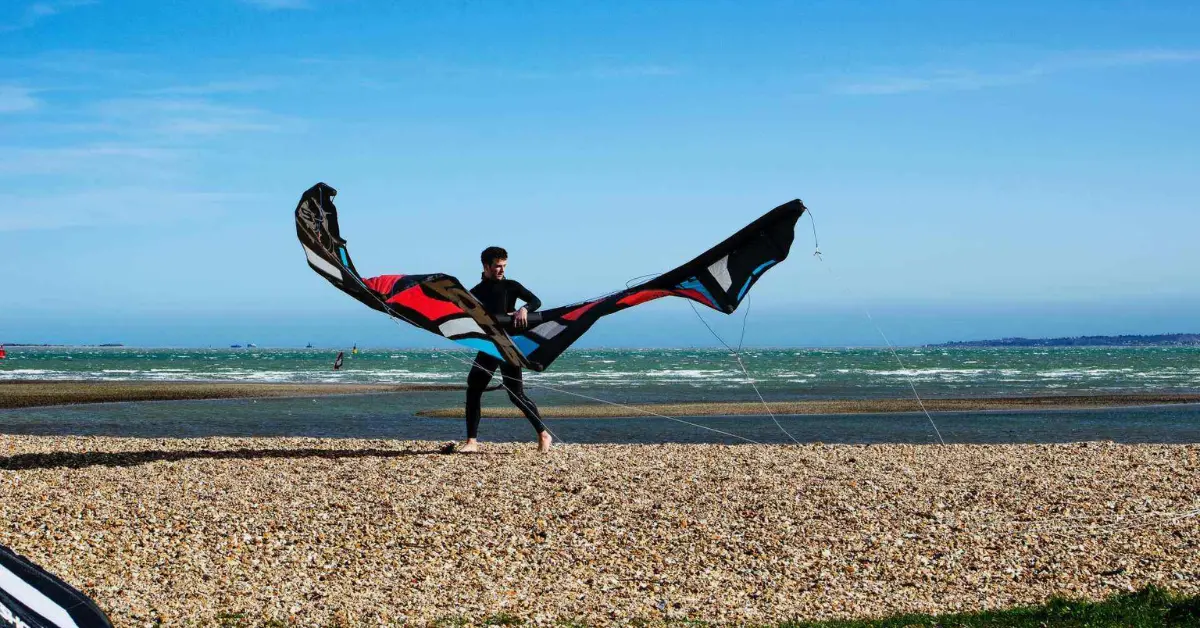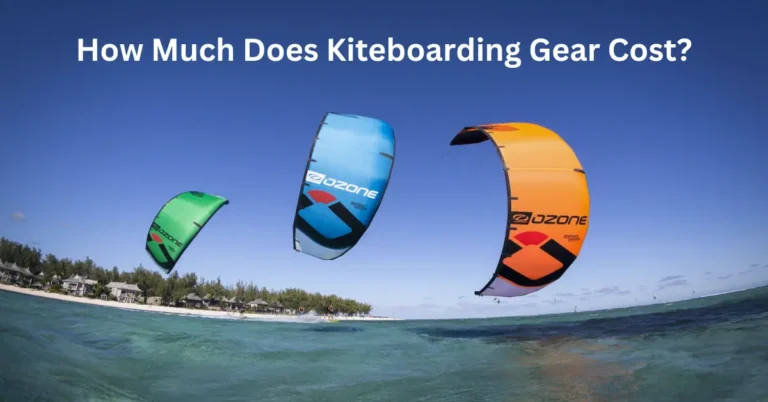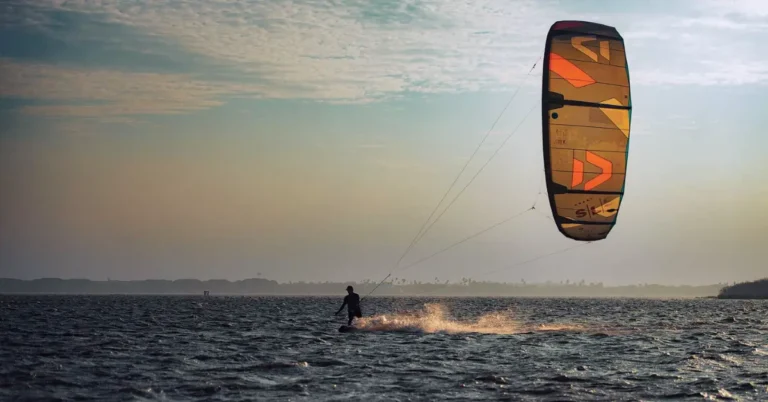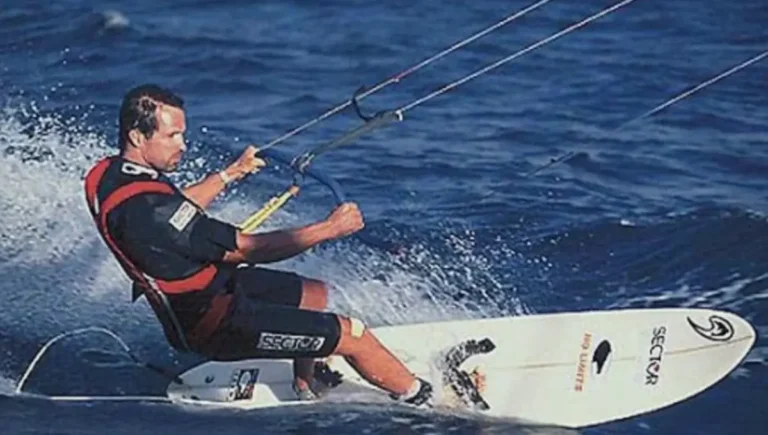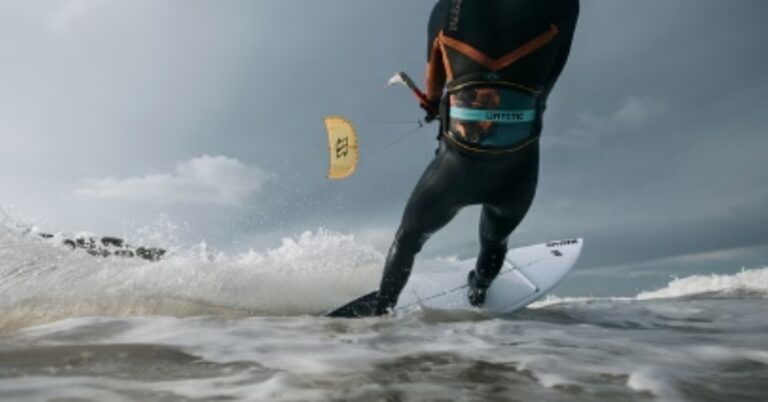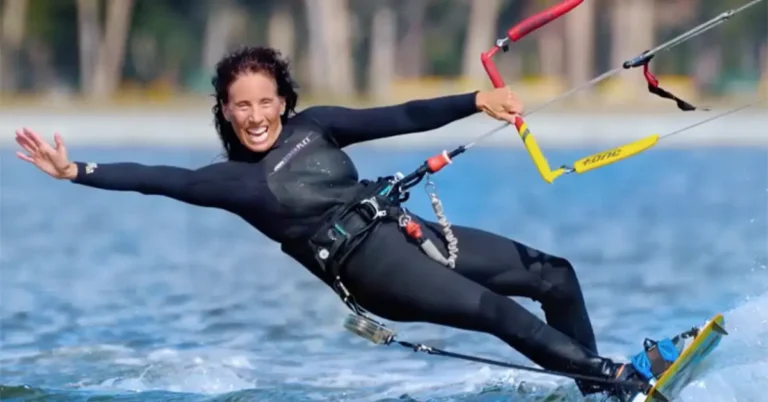Why Is Kitesurfing Fun (and How Does It Work)?
Kitesurfing brings together the excitement from different sports like windsurfing, wakeboarding, snowboarding, skateboarding, paragliding, and surfing. You glide over the ocean on a board while your kite catches the wind and moves you forward. While flying kites have been around for ages, kitesurfing as a modern sport is quite recent.
But it’s gaining popularity among adventure lovers worldwide, becoming one of the most sought-after water sports. It’s a thrilling experience that combines the joy of riding waves with the thrill of soaring through the air, making it a favorite among adrenaline junkies everywhere.
Also Read: Kitesurfing: How I Learnt to Fly
What Does Kitesurfing Involve?
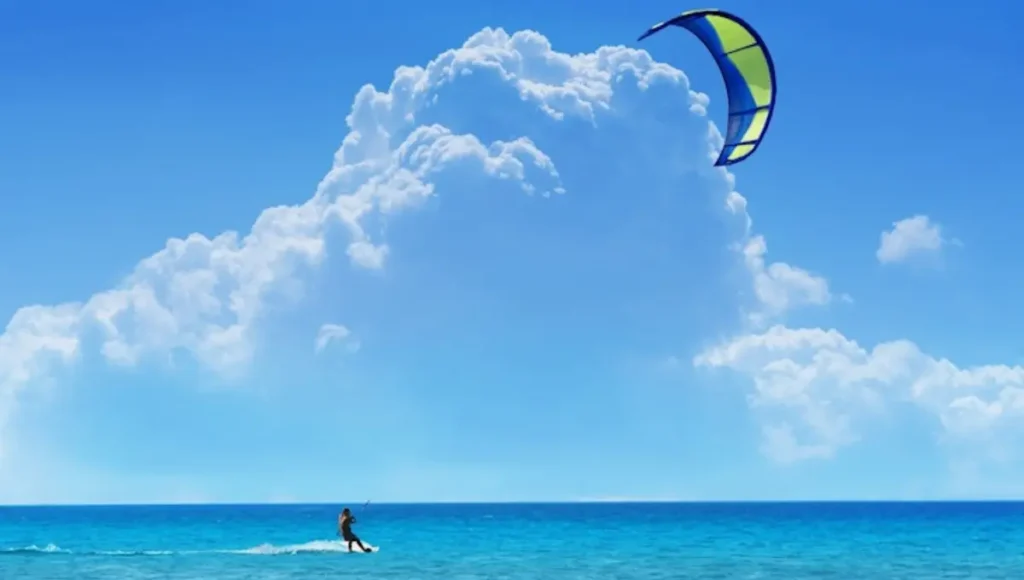
Kitesurfing isn’t like other water activities that concentrate on just one thing. It mixes elements from various sports like wakeboarding, windsurfing, paragliding, surfing, snowboarding, and skateboarding. When you’re on the board (which is like a mix of a snowboard, skateboard, and wakeboard), you’re balanced while being connected to a kite controlled by hand.
The wind powers your movements and directs the board. This unique combination of skills and equipment makes kitesurfing an exciting and challenging sport that attracts adventure seekers from all over.
How Does a Kitesurfing Kite Work?
When you see a kitesurfing kite, you might think it just goes with the wind, but it’s more like an airplane wing slicing through the air. Four forces act on the kite: lift, weight, thrust, and drag.
How Fast Can a Kitesurfer Go?
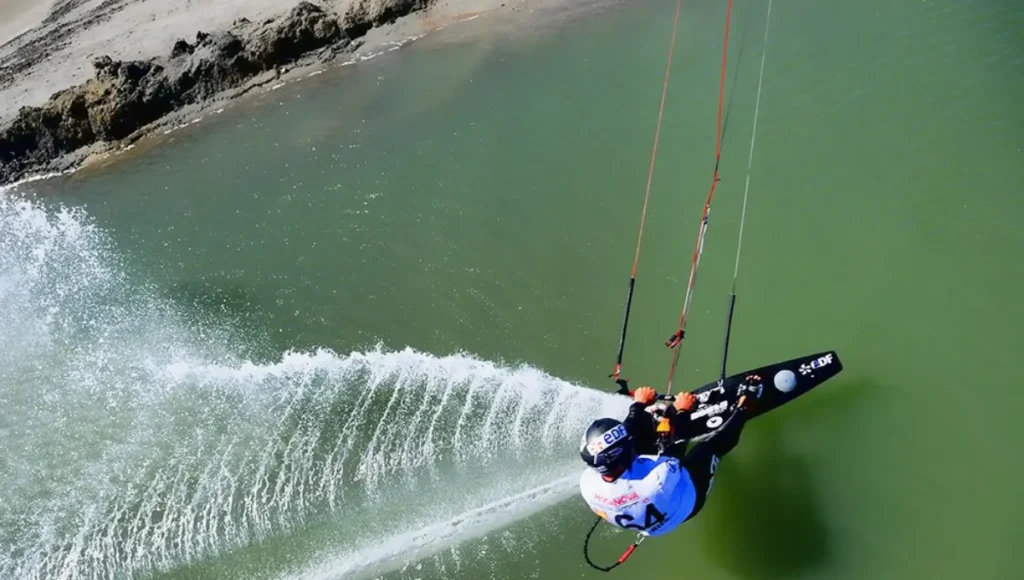
Typically, kitesurfers zip along at speeds of 15 to 25 miles per hour (mph). But this speed can change depending on factors like the person’s skill level, wind speed, water conditions, type of board, and kite size.
Skilled kitesurfers, especially pros, can reach blazing speeds of 50 to 60 mph when conditions are perfect. Even regular kitesurfers can hit speeds twice the average, zooming at around 40 mph if everything aligns just right with the wind and water.
How Do Kitesurfers Not Fly Away?
One common fear in kitesurfing is the worry of getting carried away and not being able to land. However, the science behind kitesurfing ensures this won’t happen. Kites function as wings for kitesurfers, but they can’t generate constant upward lift.
Once you’re riding, the kite can’t just shoot up into the sky like a hot air balloon until you intentionally lift off. So, while it’s natural to have concerns, rest assured that the kite won’t unexpectedly take you on an uncontrollable flight.
How Popular Is Kitesurfing?
While kitesurfing isn’t the most popular water sport, it’s gaining momentum lately. Many who used to windsurf have switched to kitesurfing, finding it more exciting. Fans of kitesurfing often travel to hotspots like Mui Ne in Vietnam to chase the wind.
Across the globe, there are plenty of kitesurfing competitions for all skill levels, providing opportunities for enthusiasts to showcase their talents. This growing interest in kitesurfing shows that it’s becoming a preferred choice for those seeking thrills on the water.
How Many Kitesurfers Are There in the World?
Back in 2008, there were only around 250,000 kitesurfers worldwide. But in recent times, that number has shot up significantly. Nowadays, there are estimated to be millions of kitesurfers across the globe, coming from diverse backgrounds. As more kitesurfing spots are discovered around the world, the number of enthusiasts is expected to keep rising.
To meet the growing demand, kitesurfing schools are popping up everywhere, welcoming eager newcomers to the sport. This surge in interest demonstrates how kitesurfing is capturing the attention of people from all walks of life.
How Old Is Kitesurfing?
Around 2,800 years ago, people in China began using kites for various purposes like sending messages, measuring distances, checking the wind, and military communication. But it wasn’t until the 1800s that someone had the idea to use a kite to move vehicles.
The roots of kitesurfing can be traced back to ancient China in the 13th century. This shows that while the sport itself is relatively recent, the scientific principles behind it have been known and utilized by people for many centuries.
Who Invented Kitesurfing?
Modern kitesurfing owes its creation to three individuals. In 1977, a Dutchman named Gijsbertus Adrianus Panhuise patented a watersport called kitesurfing, but it didn’t catch on commercially.
However, the real breakthrough came from brothers Bruno and Dominique Legaignoux in the late 1970s and early 1980s. They developed the kites specifically for the sport and patented an inflatable kite design in 1984. This design became the foundation for companies to create their kites, propelling the sport of kitesurfing forward.
Where Did Kitesurfing Originate?
The Legaignoux brothers crafted their kite prototype along the Atlantic coast of France. Their patented inflatable kite marked a significant step forward for modern kitesurfing kites. Their innovation inspired others to create their kitesurfing inventions.
For instance, the American father and son duo Bill Roeseler and Cory Roeseler developed the kite-ski, earning their patents. Additionally, the Legaignoux brothers themselves designed another kite known as “Wipika” between 1996 and 1997. These inventions further propelled the evolution of kitesurfing equipment.
Is Kitesurfing a Sport?
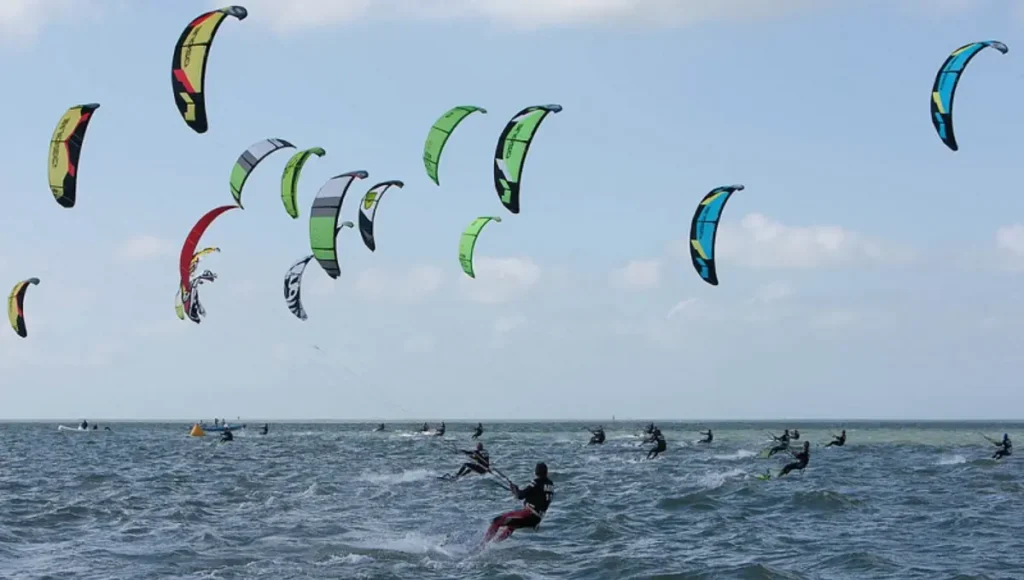
Kitesurfing is a thrilling water sport that some even label as extreme due to its intensity and the risks involved. It blends elements from skateboarding, wakeboarding, paragliding, snowboarding, surfing, and windsurfing. This sport demands endurance, core strength, balance, and focus.
Kitesurfers must not only be physically fit but also mentally prepared to face the challenges posed by unpredictable wind and water conditions. It’s not just about strength; it’s also about staying calm and sharp to navigate through the elements safely. Kitesurfing truly puts both the body and mind to the test.
Is Kitesurfing an Olympic Sport?
Kitesurfing isn’t part of the Olympics yet. To become an Olympic sport, the World Sailing (WS) organization, in charge of sailing, needs to propose it to the International Olympic Committee (IOC). But the good news is, there are plenty of kitesurfing competitions happening worldwide, both locally and internationally.
These competitions take place in some of the best kitesurfing spots globally, such as Haugastol in Norway, Zandvoort in the Netherlands, Cape Town in Africa, Cape Hatteras in North Carolina, and Melbourne in Australia. This offers kitesurfers the chance to showcase their skills and passion on a competitive stage.
Who Is the Best Kitesurfer in the World?
Determining the absolute best kitesurfer worldwide is challenging for a couple of reasons. Firstly, kitesurfing boasts numerous legendary figures. Secondly, the sport encompasses various disciplines, making it tough to rank competitors accurately. Among the renowned kitesurfing legends are Mitu Monteiro, Matchu Lopes, James Carew, Liam Whaley, and Gisela Pulido.
Each of these athletes has made significant contributions to the sport and earned acclaim for their exceptional skills and achievements. While it’s hard to crown one as the ultimate best, these individuals stand out as top performers in the world of kitesurfing.
Who Is the Kitesurfing World Champion?
| Discipline | Female Kitesurfing Champion | Male Kitesurfing Champion |
| Strapless | Carla Herrera | Airton Cozzolino |
| Freestyle | Mikaili Sol | Valentin Rodriguez |
| Big Air | Kevin Langeree <br> Jesse Richman | |
| Hydrofoil | Daniela Moroz | Theo de Ramecourt |
What Is Freeride Kitesurfing?
Freeride stands as the classic and widely practised way of kitesurfing, likely the first style newcomers will learn. This discipline covers a range of moves, from easy cruising to more advanced tricks like jumps and grabs. For freeride, simpler and adaptable equipment is often preferred.
The favoured kite type is the “delta shape,” recognized by its D shape upfront and flat profile. Additionally, freeride kitesurfers typically opt for twin tip boards as they provide a smoother riding experience. This style allows riders to explore and enjoy the sport’s basics while leaving room for progression and skill development.
Why Do People Like Kitesurfing?
People are drawn to kitesurfing for a variety of reasons. Firstly, it offers an exhilarating experience of riding waves while being propelled by the wind, providing a sense of freedom and adventure. The feeling of gliding across the water’s surface with the wind in your sails is unmatched.
Additionally, mastering the techniques required for kitesurfing provides a sense of accomplishment and challenge. Moreover, kitesurfing allows individuals to connect with nature, enjoying the beauty of the ocean and the thrill of harnessing the power of the wind. Overall, kitesurfing appeals to those seeking excitement, adrenaline, skill development, and a deeper connection with the elements.
Benefits of Kitesurfing
Kitesurfing offers numerous benefits for both your physical and mental well-being. Here are the top 10 reasons why kitesurfing is so good for you:
Frequently Asked Questions
Conclusion
Kitesurfing is undeniably fun due to its unique blend of excitement, challenge, and freedom. The sport offers an exhilarating experience of riding waves while being propelled by the wind, providing a sense of adventure and adrenaline rush.
Additionally, mastering the skills required for kitesurfing, such as controlling the kite and navigating through various conditions, adds to the enjoyment and sense of accomplishment.
Moreover, the social aspect of kitesurfing, fostering friendships and a sense of community, enhances the overall experience. Ultimately, kitesurfing is more than just a sport; it’s a thrilling and fulfilling lifestyle embraced by enthusiasts worldwide.
